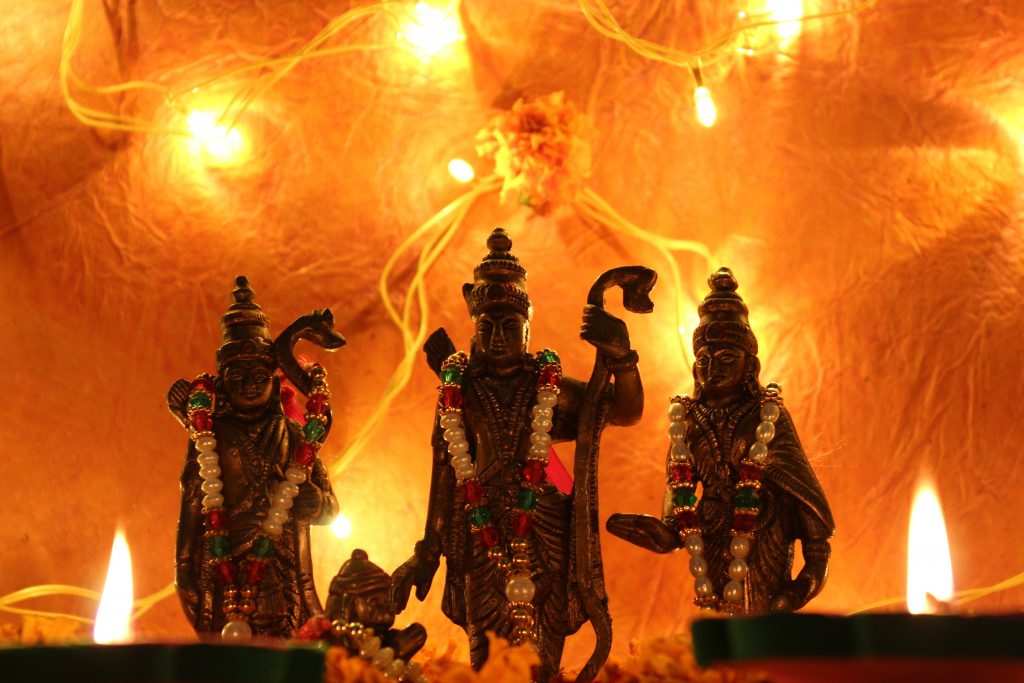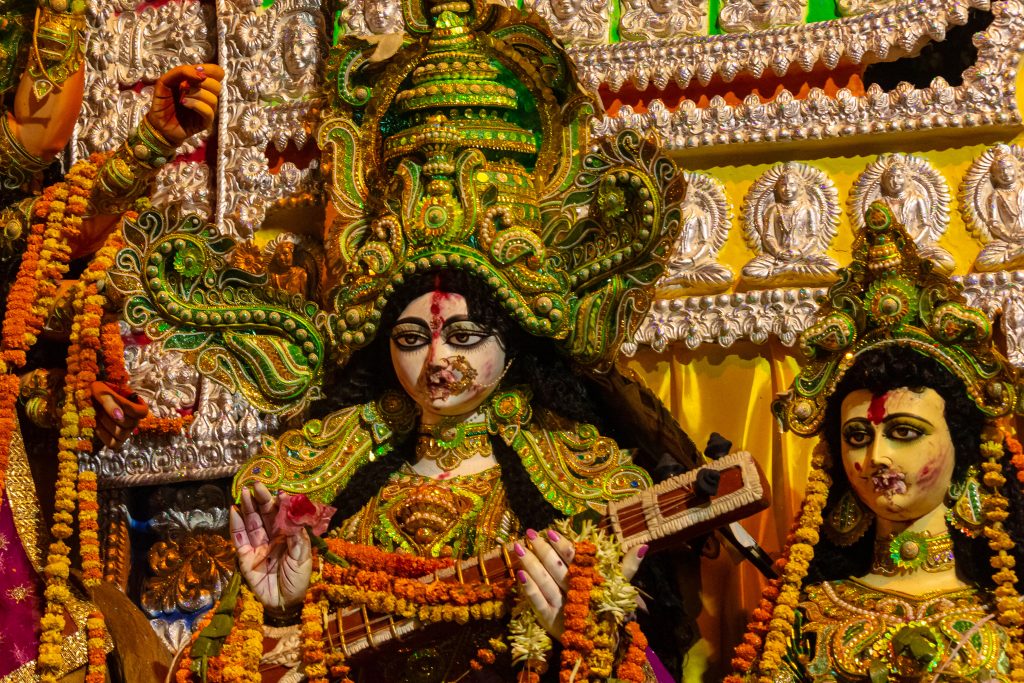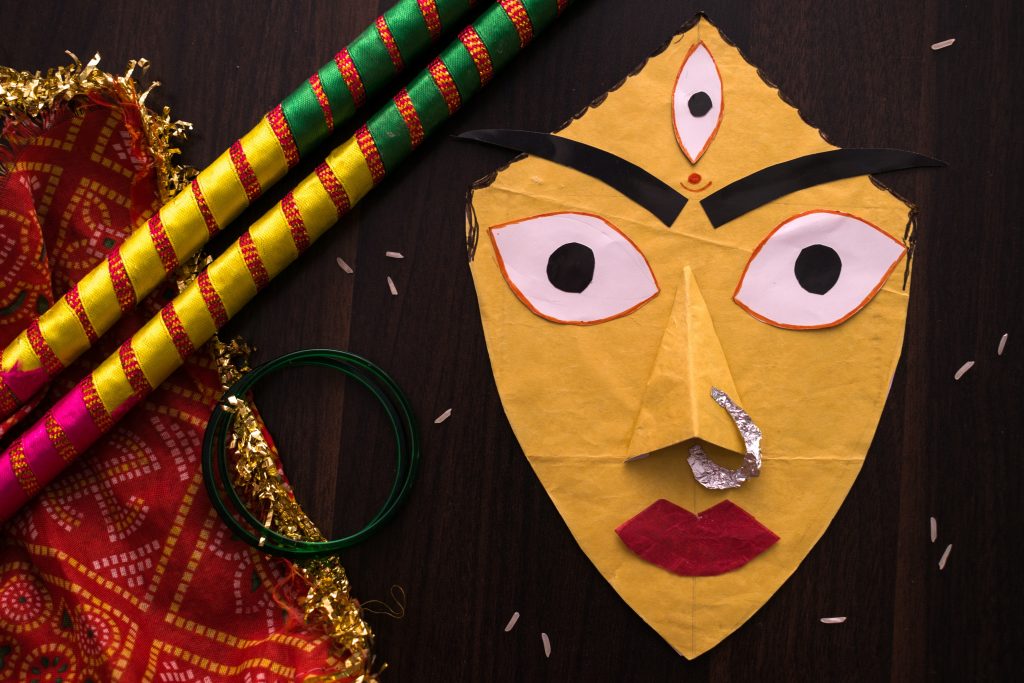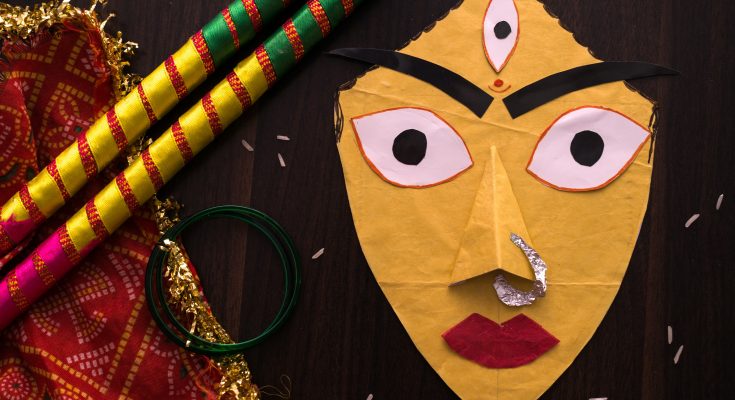The three essays on Dussehra explore the festival’s significance in Indian culture, highlighting its celebration of good over evil through the stories of Lord Rama’s victory over Ravana and Goddess Durga’s triumph over Mahishasura. They detail the diverse regional celebrations across India, from effigy burnings and dramatic reenactments to devotional dances and rituals, emphasising Dussehra’s moral and cultural importance in fostering righteousness, unity, and respect for the feminine divine.
Table of Contents
Short Essay on Dussehra – 200 words
Dussehra- A Glimpse into India’s Cultural Celebration

Dussehra, also known as Vijayadashami, is one of the most celebrated festivals in India. It marks the victory of good over evil, and is observed on the tenth day of the Hindu month of Ashwin.
The festival is primarily associated with the story of Lord Rama and the demon king Ravana. According to the Ramayana, Rama defeated and killed Ravana on this day. Thus, Dussehra symbolises the triumph of righteousness over wickedness.
Across India, the day is commemorated with much enthusiasm. Large effigies of Ravana, filled with fireworks, are set ablaze in open fields, symbolising the destruction of evil. Children and adults alike gather to watch these effigies burn, amidst the cheering and bursting of crackers.
Another important aspect of Dussehra is the role of Goddess Durga. In some regions, it is believed that on this day, Goddess Durga defeated the buffalo demon Mahishasura. Hence, grand processions and plays depicting this story are organised.
Moreover, Dussehra is a time for families to come together, exchange gifts and sweets, and revel in the festive spirit. The message of Dussehra is clear- no matter how strong evil may seem, good will always prevail. It serves as a reminder for us to always stand up against wrongdoing and strive for righteousness.
Essay on Dussehra – 500 words

Dussehra- Celebrating Triumph and Tradition in India
Dussehra, also known as Vijayadashami, is one of India’s most significant festivals. Celebrated across the country with zeal and enthusiasm, Dussehra marks the victory of good over evil. The word ‘Dussehra’ can be split into ‘Dus’, which means ten, and ‘Hara’, which means defeated. So, the word signifies the defeat of the ten-headed demon, Ravana, by Lord Rama. This festival teaches us that no matter how powerful the wrong might seem, the right will always win in the end.
Also Check – Diwali Essay Collection
Historical Significance-
The story behind Dussehra takes us back to the ancient Hindu epic, the Ramayana. It narrates the tale of Lord Rama, the prince of Ayodhya, who embarks on a quest to rescue his wife, Sita, from the demon king, Ravana. Ravana had ten heads, each representing a different vice, such as anger, lust, greed, and jealousy. After a fierce battle that lasted for days, Lord Rama, with the help of his devoted followers, defeated Ravana on the tenth day. This victory of Lord Rama is celebrated as Dussehra.
In another story, Dussehra marks the day when Goddess Durga vanquished the buffalo demon, Mahishasura. This legend is particularly popular in Eastern India.
Celebrations Across India-
Dussehra is celebrated in various ways across different parts of India. In North India, particularly in states like Uttar Pradesh, Delhi, and Punjab, grand plays and dramas called ‘Ramleela’ are staged. These plays depict the life of Lord Rama, culminating in the fiery battle with Ravana. On the tenth day, large effigies of Ravana, along with his brother Kumbhakarna and son Meghnad, are filled with firecrackers and set ablaze. Crowds gather in open fields to witness this spectacle, with the sky lighting up in bright colours.
In the South, East, and some parts of Western India, the festival emphasises the victory of Goddess Durga over Mahishasura. Here, the last ten days leading up to Dussehra are celebrated as Navaratri, where nightly dances and prayers are held in honour of the goddess.
West Bengal is famous for its Durga Puja celebrations during this time. Huge artistic clay idols of Goddess Durga depicting her victory over Mahishasura are displayed in pandals. On the tenth day, these idols are taken in processions and immersed in rivers or seas.
In states like Karnataka, the day is observed by remembering the victory of the Pandavas in the Mahabharata. People also worship tools, instruments, and books on this day, seeking blessings for success in their respective fields.
Personal Reflection-
Dussehra serves as a beacon of hope. It reminds us that challenges and adversities, symbolised by the ten-headed Ravana or the powerful Mahishasura, are a part of life. However, with determination, righteousness, and the support of loved ones, one can overcome any obstacle.
In our day-to-day life, the festival inspires us to let go of our vices and to embrace virtues. Just as communities come together to celebrate Dussehra, it underlines the importance of unity and togetherness.
Conclusion-
Dussehra is more than just a festival. It is a celebration of the human spirit, of the eternal fight against wrong, and of the ultimate victory of good. Whether it’s the burning effigies of Ravana or the rhythmic beats of the dhol during Durga Puja, the essence remains the same- good will always triumph over evil. As we celebrate Dussehra, let’s strive to internalise this message and bring about positive changes in our lives.
Long Essay on Dussehra -1000 -1200

Dussehra- Historical Roots, Regional Celebrations, and Moral Significance
Introduction-
Dussehra, also known as Vijayadashami, holds a special place in the hearts and minds of Indians. This festival, celebrated all over India, is not just about festivities and joy, but it’s also a reminder of the eternal triumph of good over evil. Delving deeper into the festival reveals a rich tapestry of history, culture, and traditions.
Historical Roots-
Dussehra is grounded in the ancient scriptures of India. The two principal narratives revolve around the Ramayana and the Devi Mahatmya.
Ramayana and Lord Rama’s Victory-
Background- The Ramayana is one of the two major Sanskrit epics of ancient India (the other being the Mahabharata). Penned by Sage Valmiki, it revolves around the life and adventures of Prince Rama of Ayodhya, his loyalty and dedication to dharma (righteousness), and his unwavering love for his wife, Sita.
The Abduction- The central conflict of the Ramayana arises when Ravana, the ten-headed king of Lanka, succumbs to his desires and kidnaps Sita during Rama’s exile in the forest. This act sets into motion a series of events leading to the grand battle between Rama and Ravana.
Allies and Assistance- While Rama’s prowess as an archer is unparalleled, his journey to rescue Sita is marked by forming alliances, most notably with Hanuman (a devoted follower with immense strength) and the Vanaras, a tribe of powerful monkey-like beings. Their collective efforts, marked by challenges, battles, and episodes of deep emotional introspection, culminate in the great war against Ravana.
Victory on Vijayadashami- After ten days of intense battle, Rama, using a special arrow, vanquishes Ravana, leading to the latter’s demise. This day, marking Rama’s victory, is celebrated as Dussehra or Vijayadashmi.
Goddess Durga and Mahishasura-
Source of the Tale- The story of Goddess Durga and Mahishasura is primarily sourced from the Devi Mahatmya, a text within the Markandeya Purana. It’s a seminal work in Shaktism, a tradition that worships the feminine divine.
The Tyrant Demon- Mahishasura, a buffalo demon, had acquired a boon that rendered him invulnerable to any man or god. Armed with this power, he wreaked havoc in the heavens, driving the gods out and establishing his own tyranny.
Emergence of Durga- Unable to bear his oppression, the gods sought a solution. From their collective energies emerged Goddess Durga, a divine warrior with ten arms, each wielding a weapon given by various deities. She rode a lion and was the embodiment of the feminine divine’s immense power.
The Epic Battle- For nine nights and ten days, a fierce battle raged between Durga and Mahishasura. Each day marked a significant event where the Goddess had to face different challenges and demons sent by Mahishasura. However, on the tenth day, she managed to slay the seemingly invincible demon, restoring peace and dharma.
Navratri and Dussehra- The battle’s nine nights gave birth to the Navratri festival, where each night is dedicated to a particular form of the Goddess. The tenth day, marking her victory, is celebrated as Dussehra.
Regional Celebrations-
North India-
In places like Delhi, Uttar Pradesh, and Punjab, the celebration is deeply tied to the narrative of the Ramayana. The most notable event is the ‘Ramleela’, which are theatrical performances of episodes from Rama’s life, culminating in his battle with Ravana.
Ramleela- Spanning over ten days, local actors perform this epic tale in open fields or staged arenas. These plays are not just religious renditions but also socio-political commentaries relevant to the times.
Effigy Burning- The tenth day witnesses the burning of large effigies of Ravana, Kumbhakarna, and Meghnad. These structures, often made of bamboo, paper, and cloth, are filled with fireworks. The ritual symbolises the destruction of evil and is watched by massive gatherings.
West Bengal and East India-
Durga Puja is the central theme in these regions, especially in West Bengal.
Idol Making and Installation- Artisans start crafting the idols months in advance. These depict Goddess Durga in her majestic form, defeating the buffalo demon, Mahishasura.
Pujas and Festivities- For five days, the idols are worshipped with elaborate rituals. Streets are lined with decorative lights, thematic pandals (temporary structures), and cultural programs.
Immersion- On ‘Vijayadashami’, processions carry the idols to rivers or lakes, where they are immersed, symbolising the Goddess’s return to her abode.
South India-
States like Karnataka, Tamil Nadu, Andhra Pradesh, and Kerala have distinct traditions.
Ayudha Puja- On Vijayadashami, people clean, decorate, and worship their tools, instruments, and books, seeking divine blessings for success.
Vidyarambham- Particularly in Kerala, young children are introduced to learning. They are taught to write their first letters on this auspicious day, signifying the beginning of their educational journey.
Gujarat-
Navaratri celebrations in Gujarat are vibrant and full of energy.
Garba and Dandiya- These are traditional dances performed during the nine nights of Navratri. While ‘Garba’ is danced in circles representing the cycle of life, ‘Dandiya’ involves rhythmic clashing of sticks. Both men and women participate, adorned in colourful traditional attire.
Himachal Pradesh-
Kullu Dussehra is a unique festival in the Kullu valley.
Kullu Dussehra- Unlike the rest of India, where Dussehra lasts for ten days, in Kullu, it starts on Vijayadashami and continues for seven days. It begins when the rest of the country wraps up the celebrations.
Procession of Deities- Hundreds of local deities are brought on elaborately decorated palanquins to the fairgrounds in Kullu, to pay homage to Lord Raghunath (another name for Lord Rama). This gathering is a colourful and grand spectacle, with traditional music and dance, reflecting the rich cultural heritage of the region.
Cultural and Moral Significance-
Triumph of Good over Evil-
Universal Message- Every culture and civilization cherishes stories where good triumphs over evil. Such narratives serve as moral compasses, guiding societies through challenging times. Dussehra epitomises this theme, ensuring its relevance across generations.
Personal Morality- On a personal level, the victory of Lord Rama over Ravana, or Goddess Durga over Mahishasura, can be likened to an individual’s daily struggle against negative tendencies. It serves as a reminder that, no matter how daunting the odds, righteousness can prevail if one remains steadfast in their beliefs and actions.
Societal Implications- In larger societal terms, the celebration reinforces the idea that corrupt, tyrannical forces will eventually be defeated. This fosters hope and resilience among communities, encouraging them to uphold justice and integrity.
Unity and Strength-
Collective Effort- The Ramayana showcases that Rama, despite being divine, required the assistance of various beings, from his brother Lakshmana to the humble squirrel. This amplifies the idea that unity and collaboration are vital for success.
Message of Solidarity- Hanuman, the devoted Vanaras, and even the birds, such as Jatayu, contributed to Rama’s quest. Their diverse backgrounds and capabilities underscore the value of inclusiveness and solidarity.
Durga’s Collective Worship– The collective veneration during Durga Puja, where entire communities come together, highlights the power of communal harmony. It’s a testimony to the idea that when communities unite in purpose and prayer, powerful positive change can manifest.
Respect for Women-
Elevation of the Feminine- Both central narratives associated with Dussehra involve women – Sita in the Ramayana and Goddess Durga. Their pivotal roles signify the importance and power of the feminine.
Sita’s Strength- While Sita’s abduction is a pivotal event in the Ramayana, it’s essential to note her strength and resilience during her captivity. She remains steadfast in her love and belief, epitomising moral fortitude.
Goddess Durga as the Protector- Durga, often depicted with eight or ten arms, wielding weapons and riding a lion, is a symbol of power and protection. Her triumph over the buffalo demon Mahishasura is not just a tale of victory but an affirmation of feminine strength and agency.
Contemporary Implications- In today’s context, the reverence shown towards Sita and Goddess Durga during Dussehra serves as a reminder of the importance of gender equality and the need to respect and uphold women’s rights, dignity, and potential.
Conclusion-
Dussehra isn’t just a day of jubilation but is a reservoir of lessons and cultural richness. It teaches resilience, righteousness, and the importance of unity. As the effigies burn or as the Goddess is venerated, we’re reminded annually of our roots, our values, and the timeless message of good prevailing over evil. By understanding the deeper significance of Dussehra, we not only connect with our cultural heritage but also equip ourselves with values essential for a harmonious life.



